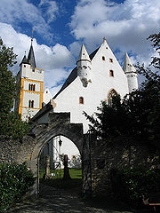
Ingelheim am Rhein
Encyclopedia
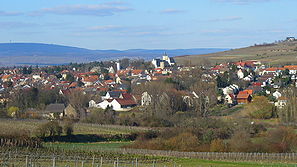
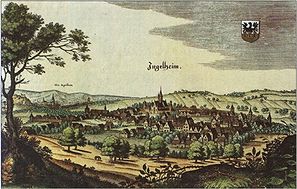
Mainz-Bingen
Mainz-Bingen is a district in the east of Rhineland-Palatinate, Germany. Neighboring districts are Rheingau-Taunus, the district-free cities Wiesbaden and Mainz, the districts Groß-Gerau, Alzey-Worms, Bad Kreuznach, Rhein-Hunsrück.-History:During the French occupation under Napoleon the district...
district in Rhineland-Palatinate
Rhineland-Palatinate
Rhineland-Palatinate is one of the 16 states of the Federal Republic of Germany. It has an area of and about four million inhabitants. The capital is Mainz. English speakers also commonly refer to the state by its German name, Rheinland-Pfalz ....
, Germany
Germany
Germany , officially the Federal Republic of Germany , is a federal parliamentary republic in Europe. The country consists of 16 states while the capital and largest city is Berlin. Germany covers an area of 357,021 km2 and has a largely temperate seasonal climate...
on the Rhine’s west bank. The town calls itself the Rotweinstadt (“Red Wine Town”) and since 1996 it has been Mainz-Bingen’s district seat.
From the later half of the 8th century, the Ingelheim Imperial Palace, which served emperors and kings as a lodging and a ruling seat until the 11th century, was to be found here.
Etymology
The typically Rhenish-Hessian placename ending —heim might well go back to FrankishFranks
The Franks were a confederation of Germanic tribes first attested in the third century AD as living north and east of the Lower Rhine River. From the third to fifth centuries some Franks raided Roman territory while other Franks joined the Roman troops in Gaul. Only the Salian Franks formed a...
times, that is to say, likely as far back as the 5th or 6th century. Settlements or estates then took their lords’ names and were given this suffix, which means “home” in German
German language
German is a West Germanic language, related to and classified alongside English and Dutch. With an estimated 90 – 98 million native speakers, German is one of the world's major languages and is the most widely-spoken first language in the European Union....
. The name is recorded in later documents as Ingilinhaim, Ingilinheim (782), Ingilenhaim, Engelheim, Hengilonheim, Engilonheim (822), Engilinheim (826), Hingilinheim (855), Ingilunheim (874), Ingulinheim (889), Ingelesheim (891), Ingelenheim (940), Anglia sedes (1051), Ingilheim and Ingelnheim (1286), among other forms.
Since 1269, a distinction has been made between Nieder-Ingelheim and Ober-Ingelheim (Lower and Upper Ingelheim)
Geography
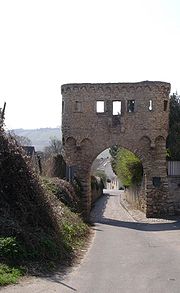
Location
Ingelheim am Rhein lies in the north of Rhein Hessen on the so-called Rhein Knee, west of the state capital, MainzMainz
Mainz under the Holy Roman Empire, and previously was a Roman fort city which commanded the west bank of the Rhine and formed part of the northernmost frontier of the Roman Empire...
. The Rhein forms the town’s northern limit. Southwards, the town stretches into the valley of the river Selz
Selz
The Selz is a river in Rhineland-Palatinate, Germany, a left tributary to the Rhine. It flows through the biggest German wine region, which is called Rheinhessen....
, which empties into the Rhein in the constituent community of Ingelheim-Nord (“North”).
The constituent communities of Ingelheim-Mitte and Ingelheim-Süd (“Middle” and “South”) are nestled against the corner of the so-called Mainzer Berg (“Mainz Mountain”).
The municipal area’s lowest point is the harbour on the Rhein at 80.8 m above sea level
Above mean sea level
The term above mean sea level refers to the elevation or altitude of any object, relative to the average sea level datum. AMSL is used extensively in radio by engineers to determine the coverage area a station will be able to reach...
. The two highest points are the Mainzer Berg at 247.8 m above sea level and the Westerberg at 247.5 m above sea level.
An obelisk on the south side of the village in direction Wackernheim, marks the road begun by Charlemagne, and completed by Napoleon. From this point a fine prospect of the entire Rheingau could be obtained.
Municipal area’s extent
The municipal area’s north-south extent is 7.9 km, while the east-west extent is 5 km.Neighbouring municipalities
Clockwise from the north, these are GeisenheimGeisenheim
Geisenheim is a town in the Rheingau-Taunus-Kreis in the Regierungsbezirk of Darmstadt in Hessen, Germany, and is known as Weinstadt , Schulstadt , Domstadt and Lindenstadt ....
, Oestrich-Winkel
Oestrich-Winkel
Oestrich-Winkel is a town in the Rheingau-Taunus-Kreis in the Regierungsbezirk of Darmstadt in Hesse, Germany.- Location :This is a young town with roughly 12,000 inhabitants, having come into being in 1972 through the merger of the self-governing communities of Mittelheim, Oestrich and Winkel;...
on the Rhine’s right bank, and on the left bank Heidesheim am Rhein
Heidesheim am Rhein
Heidesheim am Rhein is an Ortsgemeinde – a municipality belonging to a Verbandsgemeinde, a kind of collective municipality – in the Mainz-Bingen district in Rhineland-Palatinate, Germany. It is the administrative seat of the Verbandsgemeinde of Heidesheim am Rhein, which also includes the...
, Wackernheim
Wackernheim
Wackernheim is an Ortsgemeinde – a municipality belonging to a Verbandsgemeinde, a kind of collective municipality – in the Mainz-Bingen district in Rhineland-Palatinate, Germany.It is home to the United States Army's McCulley Barracks.- Location :...
(both belonging to the Verbandsgemeinde of Heidesheim am Rhein
Heidesheim am Rhein (Verbandsgemeinde)
Heidesheim am Rhein is a Verbandsgemeinde in the district Mainz-Bingen in Rhineland-Palatinate, Germany. The seat of the Verbandsgemeinde is in Heidesheim am Rhein....
), the Verbandsgemeinde of Nieder-Olm
Nieder-Olm (Verbandsgemeinde)
Verbandsgemeinde Nieder-Olm is a collective municipality in the district Mainz-Bingen in Rhineland-Palatinate, Germany. The administrative center of the Verbandsgemeinde Nieder-Olm is located in the town of Nieder-Olm...
, Schwabenheim
Schwabenheim an der Selz
Schwabenheim an der Selz is an Ortsgemeinde – a municipality belonging to a Verbandsgemeinde, a kind of collective municipality – in the Mainz-Bingen district in Rhineland-Palatinate, Germany.- Location :...
, Gau-Algesheim
Gau-Algesheim
Gau-Algesheim is a town in the Mainz-Bingen district in Rhineland-Palatinate, Germany. It is the seat of the Verbandsgemeinde of Gau-Algesheim, a kind of collective municipality.- Location :...
(both belonging to the Verbandsgemeinde of Gau-Algesheim
Gau-Algesheim (Verbandsgemeinde)
Gau-Algesheim is a Verbandsgemeinde in the district Mainz-Bingen in Rhineland-Palatinate, Germany. The seat of the Verbandsgemeinde is in Gau-Algesheim....
) and Bingen am Rhein
Bingen am Rhein
Bingen am Rhein is a town in the Mainz-Bingen district in Rhineland-Palatinate, Germany.The settlement’s original name was Bingium, a Celtic word that may have meant “hole in the rock”, a description of the shoal behind the Mäuseturm, known as the Binger Loch. Bingen was the starting point for the...
.
Constituent communities
Ingelheim is currently divided into six Stadtteile: Ingelheim-Mitte, Ingelheim-Nord, Ingelheim-Süd, Sporkenheim, Groß-Winternheim and Ingelheim-West. Before Ingelheim became a town in 1939, the first three centres bore the names Nieder-Ingelheim, Frei-Weinheim and Ober-Ingelheim. Official changes notwithstanding, the old names are still quite often used.Climate
The town lies in the temperate zone. The average yearly temperature in Ingelheim is 9.8 °C. The warmest months are July and August with average temperatures of 18.0 and 18.5 °C respectively, and the coldest month is January at 1.0 °C on average. The most precipitation falls in June and August with an average of 64 mm, and the least in March with an average of 31 mm. Like all Rhenish Hesse, Ingelheim, too, is sheltered from the weather by the HunsrückHunsrück
The Hunsrück is a low mountain range in Rhineland-Palatinate, Germany. It is bounded by the river valleys of the Moselle , the Nahe , and the Rhine . The Hunsrück is continued by the Taunus mountains on the eastern side of the Rhine. In the north behind the Moselle it is continued by the Eifel...
, the Taunus
Taunus
The Taunus is a low mountain range in Hesse, Germany that composes part of the Rhenish Slate Mountains. It is bounded by the river valleys of Rhine, Main and Lahn. On the opposite side of the Rhine, the mountains are continued by the Hunsrück...
, the Odenwald
Odenwald
The Odenwald is a low mountain range in Hesse, Bavaria and Baden-Württemberg in Germany.- Location :The Odenwald lies between the Upper Rhine Rift Valley with the Bergstraße and the Hessisches Ried in the west, the Main and the Bauland in the east, the Hanau-Seligenstadt Basin – a subbasin of...
and the Donnersberg
Donnersberg
For the Czech mountain, see MilešovkaThe Donnersberg is the highest peak of the Palatinate region of Germany. The mountain lies between the towns of Rockenhausen en Kirchheimbolanden, in the Donnersbergkreis district, which is named after the mountain. The highway A63 runs along the southern edge...
, thereby limiting the yearly precipitation to only 560 mm.
| Month | Jan | Feb | Mar | Apr | May | Jun | Jul | Aug | Sep | Oct | Nov | Dec | Year |
|---|---|---|---|---|---|---|---|---|---|---|---|---|---|
| Temperature Temperature Temperature is a physical property of matter that quantitatively expresses the common notions of hot and cold. Objects of low temperature are cold, while various degrees of higher temperatures are referred to as warm or hot... (°C) |
1.0 | 2.0 | 4.5 | 9.5 | 14 | 17 | 18 | 18 | 14.5 | 10.5 | 5 | 2 | |
| Precipitation Precipitation (meteorology) In meteorology, precipitation In meteorology, precipitation In meteorology, precipitation (also known as one of the classes of hydrometeors, which are atmospheric water phenomena is any product of the condensation of atmospheric water vapor that falls under gravity. The main forms of precipitation... (mm) |
40 | 35 | 31 | 36 | 52 | 64 | 59 | 64 | 45 | 40 | 51 | 43 | |
| Source: Deutscher Wetterdienst | |||||||||||||
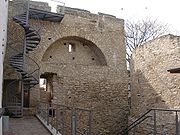
History
The Ingelheim area was already settled in prehistoric times. The place first earned itself particular importance, though, only under CharlemagneCharlemagne
Charlemagne was King of the Franks from 768 and Emperor of the Romans from 800 to his death in 814. He expanded the Frankish kingdom into an empire that incorporated much of Western and Central Europe. During his reign, he conquered Italy and was crowned by Pope Leo III on 25 December 800...
and his successors. Charlemagne had the Ingelheim Imperial Palace (Ingelheimer Kaiserpfalz) built here, where synod
Synod
A synod historically is a council of a church, usually convened to decide an issue of doctrine, administration or application. In modern usage, the word often refers to the governing body of a particular church, whether its members are meeting or not...
s and Imperial diets
Reichstag (Holy Roman Empire)
The Imperial Diet was the Diet, or general assembly, of the Imperial Estates of the Holy Roman Empire.During the period of the Empire, which lasted formally until 1806, the Diet was not a parliament in today's sense; instead, it was an assembly of the various estates of the realm...
were held in the time that followed. His son and successor, Emperor Louis the Pious
Louis the Pious
Louis the Pious , also called the Fair, and the Debonaire, was the King of Aquitaine from 781. He was also King of the Franks and co-Emperor with his father, Charlemagne, from 813...
, died on 20 June 840 in Ingelheim.
In the High and Late Middle Ages
Middle Ages
The Middle Ages is a periodization of European history from the 5th century to the 15th century. The Middle Ages follows the fall of the Western Roman Empire in 476 and precedes the Early Modern Era. It is the middle period of a three-period division of Western history: Classic, Medieval and Modern...
, the Palatinate’s, and thereby also Ingelheim’s, importance shrank.
For German justice history, the Ingelheimer Oberhof (“Ingelheim Upper Court”) is of particular importance, as a unique collection of judgments from the 15th and 16th centuries that it handed down has been preserved.
Late 19th century Ingelheim was the residence of the Dutch writer Multatuli
Multatuli
Eduard Douwes Dekker , better known by his pen name Multatuli , was a Dutch writer famous for his satirical novel, Max Havelaar , which denounced the abuses of colonialism in the Dutch East Indies .-Biography:Dekker was born in Amsterdam...
(Eduard Douwes Dekker).
In 1939, the formerly self-administering municipalities of Nieder-Ingelheim, Ober-Ingelheim and Frei-Weinheim were merged into the Town of Ingelheim am Rhein.
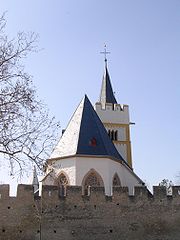
Koblenz
Koblenz is a German city situated on both banks of the Rhine at its confluence with the Moselle, where the Deutsches Eck and its monument are situated.As Koblenz was one of the military posts established by Drusus about 8 BC, the...
. Today, Ingelheim is a middle centre
Central Place Theory
Central place theory is a geographical theory that seeks to explain the number, size and location of human settlements in an urban system. The theory was created by the German geographer Walter Christaller, who asserted that settlements simply functioned as 'central places' providing services to...
in Rhineland-Palatinate, a Great District-Bound Town (Große kreisangehörige Stadt – a status deriving from the Rhineland-Palatinate Municipal Order) and the seat of district administration for Mainz-Bingen
Mainz-Bingen
Mainz-Bingen is a district in the east of Rhineland-Palatinate, Germany. Neighboring districts are Rheingau-Taunus, the district-free cities Wiesbaden and Mainz, the districts Groß-Gerau, Alzey-Worms, Bad Kreuznach, Rhein-Hunsrück.-History:During the French occupation under Napoleon the district...
.
Furthermore, Ingelheim harbours the business Boehringer Ingelheim which has become active worldwide.
Religion
In 2004, 36% of Ingelheim’s inhabitants belonged to the LutheranEvangelical Church in Germany
The Evangelical Church in Germany is a federation of 22 Lutheran, Unified and Reformed Protestant regional church bodies in Germany. The EKD is not a church in a theological understanding because of the denominational differences. However, the member churches share full pulpit and altar...
faith, and 34% were Catholic, while 24% were without any religious faith; from 2% of the population, no data were forthcoming.
The six Catholic parishes belong, within the Roman Catholic Diocese of Mainz to the Deanery
Deanery
A Deanery is an ecclesiastical entity in both the Roman Catholic Church and the Church of England. A deanery is either the jurisdiction or residence of a Dean.- Catholic usage :...
of Bingen.
The five Evangelical parishes of the EKHN belong to the Provostship (Propstei) of Mainz, and within this to the Deanery of Ingelheim.
Besides these, the Baptists, Religious humanists
Religious humanism
Religious humanism is an integration of humanist ethical philosophy with religious rituals and beliefs that center on human needs, interests, and abilities.-Origins:...
and Muslims
Islam
Islam . The most common are and . : Arabic pronunciation varies regionally. The first vowel ranges from ~~. The second vowel ranges from ~~~...
each have small communities in Ingelheim, as do the Jehovah's Witnesses
Jehovah's Witnesses
Jehovah's Witnesses is a millenarian restorationist Christian denomination with nontrinitarian beliefs distinct from mainstream Christianity. The religion reports worldwide membership of over 7 million adherents involved in evangelism, convention attendance of over 12 million, and annual...
.
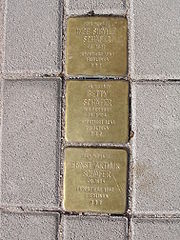
Judaism
Judaism ) is the "religion, philosophy, and way of life" of the Jewish people...
community, whose beginnings went back to the 16th century. About 1850, roughly 200 Jewish inhabitants lived in Ober-Ingelheim, and by 1933 there were still 134 all together in Oberingelheim and Niederingelheim. In 1840 and 1841, a synagogue
Synagogue
A synagogue is a Jewish house of prayer. This use of the Greek term synagogue originates in the Septuagint where it sometimes translates the Hebrew word for assembly, kahal...
that was important to architectural history was built. It was dedicated on 27 August 1841 and destroyed on 9 November 1938 – Kristallnacht
Kristallnacht
Kristallnacht, also referred to as the Night of Broken Glass, and also Reichskristallnacht, Pogromnacht, and Novemberpogrome, was a pogrom or series of attacks against Jews throughout Nazi Germany and parts of Austria on 9–10 November 1938.Jewish homes were ransacked, as were shops, towns and...
. Many Jewish inhabitants lost their lives after being deported to the death camps during the time of the Third Reich
Nazi Germany
Nazi Germany , also known as the Third Reich , but officially called German Reich from 1933 to 1943 and Greater German Reich from 26 June 1943 onward, is the name commonly used to refer to the state of Germany from 1933 to 1945, when it was a totalitarian dictatorship ruled by...
.
Before 1939
| Year | Nieder-Ingelheim | Ober-Ingelheim | Frei-Weinheim | total |
|---|---|---|---|---|
| 1815 | 1,360 | 1,738 | 192 | 3,290 |
| 1871 | 5,760 | |||
| 1885 | 2,729 | 3,160 | 701 | 6,590 |
| 1900 | 3,435 | 3,402 | 838 | 7,675 |
| 1905 | 8,098 | |||
| 1910 | 3,852 | 3,479 | 882 | 8,213 |
| 1933 | 5,157 | 4,116 | 1,183 | 10,456 |
| 1939 | 5,526 | 4,309 | 1,200 | 11,035 |
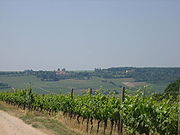
Beginning in 1939
EWLINE
|
EWLINE
|
||||||||||||||||||||||||||||||||||||||||||||||||||||
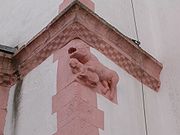
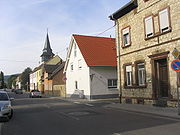
Town council
The municipal election held in 2004 yielded the following results:| Party | % | Seats |
|---|---|---|
| Christian Democratic Union of Germany | 37.53% (-4.24%) | 13 |
| Social Democratic Party of Germany Social Democratic Party of Germany The Social Democratic Party of Germany is a social-democratic political party in Germany... |
29.64% (-5.90%) | 11 |
| Grünen | 10.41% (+2.52%) | 4 |
| Liste Klose | 10.19% (+10.19%) | 4 |
| Freie Wähler | 7.30% (-2.33%) | 2 |
| Free Democratic Party Free Democratic Party (Germany) The Free Democratic Party , abbreviated to FDP, is a centre-right classical liberal political party in Germany. It is led by Philipp Rösler and currently serves as the junior coalition partner to the Union in the German federal government... |
4.93% (-0.24%) | 2 |
Mayor

| Candidate | Party | % |
|---|---|---|
| Gerhard, Dr. Joachim | CDU | 45.85% |
| Claus, Ralf | SPD | 29.51% |
| Klose, Hans-Werner | Liste Klose | 19.04% |
| Frey, Joachim | Grünen | 5.60% |
In the runoff election
Two-round system
The two-round system is a voting system used to elect a single winner where the voter casts a single vote for their chosen candidate...
on 29 June 2003, the incumbent Gerhard managed to garner 52.76% of all votes cast against Claus’s 47.24%, returning himself to office.
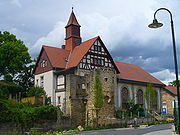
Results of council elections since 1946
- 1946
- CDU: 42.2%
- SPDSocial Democratic Party of GermanyThe Social Democratic Party of Germany is a social-democratic political party in Germany...
: 26% - KPDCommunist Party of GermanyThe Communist Party of Germany was a major political party in Germany between 1918 and 1933, and a minor party in West Germany in the postwar period until it was banned in 1956...
: 9.2% - Liste Gemünden/Gaul: 22.6%
- Eligible voters: 6,899
- Voter turnout: 88.6%
- 1948
- CDU: 35.1%
- SPD: 33.1%
- DP: 25.3%
- KP: 6.5%
- 9 November 1952
- Freie Bürgerliste Rausch: 40.1%, 2,882 votes — 11 seats
- SPD: 23.04%, 1,656 votes — 6 seats
- CDU: 22.43%, 1,612 votes — 6 seats
- FDP: 10.21%, 734 votes — 2 seats
- KPD: 4.2%, 303 votes
- Eligible voters: 9,488
- Voter turnout: 77.76%, 7378 votes, 7,187 valid votes
- 1956
- SPD: 36.79%, 2,611 votes — 9 seats
- CDU: 27.06%, 1,920 votes — 7 seats
- Wählergruppe Bambach: 24.45%, 1,735 votes — 6 seats
- FDP: 11.7%, 830 votes — 3 seats
- Eligible voters: 9,979
- Voter turnout: 72.62%, 7,247 votes, 7,096 valid votes
- 23 October 1960
- SPD: 42.61%, 3,114 votes — 11 seats
- CDU: 36.65%, 2,679 votes — 10 seats
- FDP: 16.92%, 1,237 votes — 2 seats
- Wählergruppe Kaufmann: 3.82%, 279 votes
- Eligible voters: 10,695
- Voter turnout: 70.14%, 7,502 votes, 7,309 valid votes
- 25 October 1964
- SPD: 51.7% — 13 seats (absolute majority)
- CDU: 34.7%, 2,800 votes — 9 seats
- FDP: 13.6%, 1,098 votes — 3 seats
- Eligible voters: 11,369 (50a CDU) 11,312 (40a Ing)
- Voter turnout: 72.77%, 8,231 votes (50a CDU) 8,232 (40a Ing)
- 8 June 1969
- CDU: 37.15%, 3,397 votes — 12 seats
- SPD: 34.45%, 3,150 votes — 11 seats
- FDP: 10.45%, 956 votes — 3 seats
- Freie Wählergruppe Kaege: 17.95%, 1,641 votes — 5 seats
- Eligible voters: 12,295
- Voter turnout: 75.51%, 9,309 votes, 9,144 valid votes
- 23 April 1972
- SPD: 41.99%, 4,263 votes — 14 seats (according to 40a 4,264)
- CDU: 38.92%, 3,952 votes — 12 seats
- FDP: 8.79%, 892 votes — 2 seats
- Wählergruppe Kaege: 10.28%, 1,044 votes — 3 seats
- Eligible voters: 13,992
- Voter turnout: 73.46%, 10,280 votes, 10,153 valid votes
- 17 March 1974
- CDU: 46.6%, 5,092 votes — 17 seats (40a: 46.40%)
- SPD: 34.34%, 3,769 votes — 12 seats
- FDP: 10.26%, 1,126 votes — 3 seats
- FWG: 8.98%, 986 votes — 3 seats
- Eligible voters: 14,027
- Voter turnout: 79.17%, 11,106 votes, 10,973 valid votes
- 10/11 June 1979
- SPD: 42.12%, 4,322 votes — 14 seats
- CDU: 41.52%, 4,261 votes — 13 seats
- FDP: 8.21%, 842 votes — 2 seats
- FWG: 8.15%, 837 votes — 2 seats
- Eligible voters: 14,238
- Voter turnout: 73.54%, 10,470 votes, 10,262 valid votes
- 17 June 1984
- CDU: 40.7%, 4,576 votes — 15 seats
- SPD: 44.1%, 4,966 votes — 16 seats
- FDP: 7.8% — 2 seats
- FWG: 10.6% — 2 seats
- DKP: 1 % — 112 votes
- Eligible voters: 15,408
- Voter turnout: 74.9%, 11,252 valid votes
- 18 June 1989
- SPD: 41.0% — 15 seats
- CDU: 31.2% — 11 seats
- FWG: 10.6% — 4 seats
- FDP: 7.75% — 3 seats
- Grüne: 7.38% — 2 seats
- 12 June 1994
- SPD: 36.6% — 13 seats
- CDU: 31.0% — 11 seats
- FWG: 6 seats
- Grüne: 4 seats
- FDP: 2 seats
- Voter turnout: 70%, 11,781 votes
Mayors before 1939
- Nieder-Ingelheim
- Weitzel about 1881
- Leonard Muntermann (DDP, 1912 - 7 April 1932)
- Ober-Ingelheim
- Dr. Georg Rückert (February 1932 - April 1933)
- Gaul (1933-)
(Chief) Mayors since 1939
Mayors (Bürgermeister) from 1946, Chief Mayors (Oberbürgermeister) from 1972:- 1939-1945: Franz Bambach (NSDAP)
- 15 April 1945 - 23 June 1945: Georg Schick
- 23 June 1945 - : Dr. iur. Georg Rückert (SP)
- 22 September 1946-1948: Dr. iur. Georg Rückert (SP)
- 1949 - 1 October 1956: Dr. rer. pol. Heinz Brühne (SPD)
- 1957-1964: Heinz Kühn
- 1964-1965: Albert Saalwächter
- 1966-1972: Hans-Ulrich Oehlschlägel, BM (SPD)
- 1972-1975: Hans-Ulrich Oehlschlägel, OB (SPD)
- 1975-1995: Anno Vey (CDU)
- 1995- : Dr. Joachim Gerhard (CDU)
Coat of arms
The town’s armsCoat of arms
A coat of arms is a unique heraldic design on a shield or escutcheon or on a surcoat or tabard used to cover and protect armour and to identify the wearer. Thus the term is often stated as "coat-armour", because it was anciently displayed on the front of a coat of cloth...
might be described thus: Argent an eagle displayed sable armed and langued gules.
The eagle is the Imperial Eagle. The arms have their roots in the Imperial Freedom enjoyed by the Ingelheimer Grund (Ingelheim area).
Old coats of arms


- Nieder-Ingelheim: Argent a wall embattled gules masoned sable, issuant therefrom a demi-eagle displayed of the third beaked and langued of the second.
- Ober-Ingelheim: Argent an eagle displayed sable armed, beaked and langued gules.
Sponsorships
- Airbus Ingelheim am Rhein D-ABJE, Boeing 737-530, SN 25310/2126
- Until her decommissioning on 28 June 2001 there was a partnership with S58 Pinguin, a German Navy Fast Attack CraftFast Attack CraftFast Attack Craft are small, fast, agile and offensive warships, that are armed with anti-ship missiles, guns or torpedoes. These are usually operated in close proximity to land as they lack both the sea-keeping and all-round defensive capabilities to survive in blue water. The size of the vessel...
.
Town partnerships
| City | Country | Province | Region | Year |
|---|---|---|---|---|
| Stevenage Stevenage Stevenage is a town and borough in Hertfordshire, England. It is situated to the east of junctions 7 and 8 of the A1, and is between Letchworth Garden City to the north, and Welwyn Garden City to the south.... |
United Kingdom United Kingdom The United Kingdom of Great Britain and Northern IrelandIn the United Kingdom and Dependencies, other languages have been officially recognised as legitimate autochthonous languages under the European Charter for Regional or Minority Languages... |
Shire district Non-metropolitan district Non-metropolitan districts, or colloquially shire districts, are a type of local government district in England. As created, they are sub-divisions of non-metropolitan counties in a so-called "two-tier" arrangement... |
Hertfordshire Hertfordshire Hertfordshire is a ceremonial and non-metropolitan county in the East region of England. The county town is Hertford.The county is one of the Home Counties and lies inland, bordered by Greater London , Buckinghamshire , Bedfordshire , Cambridgeshire and... |
1963 |
| Autun Autun Autun is a commune in the Saône-et-Loire department in Burgundy in eastern France. It was founded during the early Roman Empire as Augustodunum. Autun marks the easternmost extent of the Umayyad campaign in Europe.-Early history:... |
 France FranceFrance The French Republic , The French Republic , The French Republic , (commonly known as France , is a unitary semi-presidential republic in Western Europe with several overseas territories and islands located on other continents and in the Indian, Pacific, and Atlantic oceans. Metropolitan France... |
Saône-et-Loire Saône-et-Loire Saône-et-Loire is a French department, named after the Saône and the Loire rivers between which it lies.-History:When it was formed during the French Revolution, as of March 4, 1790 in fulfillment of the law of December 22, 1789, the new department combined parts of the provinces of southern... |
Burgundy | 1963 |
| Berlin-Kreuzberg Kreuzberg Kreuzberg, a part of the combined Friedrichshain-Kreuzberg borough located south of Mitte since 2001, is one of the best-known areas of Berlin... |
 Germany GermanyGermany Germany , officially the Federal Republic of Germany , is a federal parliamentary republic in Europe. The country consists of 16 states while the capital and largest city is Berlin. Germany covers an area of 357,021 km2 and has a largely temperate seasonal climate... |
Friedrichshain-Kreuzberg Friedrichshain-Kreuzberg Friedrichshain-Kreuzberg is the second borough of Berlin, formed in 2001 by merging the former East Berlin borough of Friedrichshain and the former West Berlin borough of Kreuzberg... |
Mitte Mitte Mitte is the first and most central borough of Berlin. It was created in Berlin's 2001 administrative reform by the merger of the former districts of Mitte proper, Tiergarten and Wedding; the resulting borough retained the name Mitte. It is one of the two boroughs which comprises former West and... |
1971 |
| San Pietro in Cariano San Pietro in Cariano San Pietro in Cariano is a comune in the Province of Verona in the Italian region Veneto, located about 110 km west of Venice and about 12 km northwest of Verona.... |
 Italy ItalyItaly Italy , officially the Italian Republic languages]] under the European Charter for Regional or Minority Languages. In each of these, Italy's official name is as follows:;;;;;;;;), is a unitary parliamentary republic in South-Central Europe. To the north it borders France, Switzerland, Austria and... |
Verona Province of Verona The Province of Verona is a province in the Veneto region of Italy. Its capital is the city of Verona.-Overview:The province has an area of 3,109 km², and a total population of 912,981... |
Veneto Veneto Veneto is one of the 20 regions of Italy. Its population is about 5 million, ranking 5th in Italy.Veneto had been for more than a millennium an independent state, the Republic of Venice, until it was eventually annexed by Italy in 1866 after brief Austrian and French rule... |
1984 |
| Limbach-Oberfrohna Limbach-Oberfrohna Limbach-Oberfrohna is a town in the district of Zwickau in the German Free State of Saxony.-Main sights:* Schloss Wolkenburg* Protestant church in Oberfrohna* Wasserturm * Town Hall* Limbach Municipal Church-Economy:... |
 Germany GermanyGermany Germany , officially the Federal Republic of Germany , is a federal parliamentary republic in Europe. The country consists of 16 states while the capital and largest city is Berlin. Germany covers an area of 357,021 km2 and has a largely temperate seasonal climate... |
Zwickau Zwickau (district) Zwickau is a district in the Free State of Saxony, Germany.- History :The district was established by merging the former districts Zwickauer Land, Chemnitzer Land and the urban district Zwickau as part of the district reform of August 2008.... |
Saxony Saxony The Free State of Saxony is a landlocked state of Germany, contingent with Brandenburg, Saxony Anhalt, Thuringia, Bavaria, the Czech Republic and Poland. It is the tenth-largest German state in area, with of Germany's sixteen states.... |
1990 |
| Nysa Nysa, Poland Nysa is a town in southwestern Poland on the Nysa Kłodzka river with 47,545 inhabitants , situated in the Opole Voivodeship. It is the capital of Nysa County. It comprises the urban portion of the surrounding Gmina Nysa, a mixed urban-rural commune with a total population of 60,123 inhabitants... |
 Poland PolandPoland Poland , officially the Republic of Poland , is a country in Central Europe bordered by Germany to the west; the Czech Republic and Slovakia to the south; Ukraine, Belarus and Lithuania to the east; and the Baltic Sea and Kaliningrad Oblast, a Russian exclave, to the north... |
Nysa County Nysa County Nysa County is a unit of territorial administration and local government in Opole Voivodeship, south-western Poland, on the Czech border. It came into being on January 1, 1999, as a result of the Polish local government reforms passed in 1998. Its administrative seat and largest town is Nysa,... |
Opole Voivodeship Opole Voivodeship - Administrative division :Opole Voivodeship is divided into 12 counties : 1 city county and 11 land counties. These are further divided into 71 gminas.The counties are listed in the following table .- Economy :... |
2002 |
| Afula Afula Afula is a city in the North District of Israel, often known as the "Capital of the Valley", referring to the Jezreel Valley. The city had a population of 40,500 at the end of 2009.-History:... |
 Israel IsraelIsrael The State of Israel is a parliamentary republic located in the Middle East, along the eastern shore of the Mediterranean Sea... |
North District North District (Israel) The Northern District is one of Israel's six administrative districts. The Northern District has a land area of 4,478 km², which increases to 4,638 km² when both land and water are included... |
On 24 October 1975, the three-way partnership between Ingelheim, Autun
Autun
Autun is a commune in the Saône-et-Loire department in Burgundy in eastern France. It was founded during the early Roman Empire as Augustodunum. Autun marks the easternmost extent of the Umayyad campaign in Europe.-Early history:...
and Stevenage
Stevenage
Stevenage is a town and borough in Hertfordshire, England. It is situated to the east of junctions 7 and 8 of the A1, and is between Letchworth Garden City to the north, and Welwyn Garden City to the south....
was officially sealed.
Ingelheimer Fassenacht
There is in Ingelheim a well-developed CarnivalCarnival
Carnaval is a festive season which occurs immediately before Lent; the main events are usually during February. Carnaval typically involves a public celebration or parade combining some elements of a circus, mask and public street party...
culture, which admittedly is very much under the Mainz Carnival’s influence. All together, the town counts four Carnival clubs:
- Carneval-Verein „Wäschbächer" 1885
- Carnevalverein Frei-Weinheim
- Ingelheimer Carnevalverein
- Narrenclub Ingelheim 1987 (“Fools’ Club”)
Museums
The Museum bei der Kaiserpfalz (“Museum at the Imperial Palace”) has an exhibit dedicated to the Imperial Palace built in Ingelheim after 785 by CharlemagneCharlemagne
Charlemagne was King of the Franks from 768 and Emperor of the Romans from 800 to his death in 814. He expanded the Frankish kingdom into an empire that incorporated much of Western and Central Europe. During his reign, he conquered Italy and was crowned by Pope Leo III on 25 December 800...
. On show are small archaeological finds, objects from architectural sculpture and a demonstrative model of the once imposing building. Remnants of the Imperial Palace can be seen right near the museum. Of Europe-wide importance is the golden solidus found in 1996, which is hitherto still the only gold coin ever found struck with Charlemagne’s effigy.
Music
- Further Education Centre Symphony Orchestra
- Ingelheimer Konfettis (performing and singing group)
- Ingelheim church choir
- Bläserchöre Ingelheim (wind choirs)
- Carolus Magnus-Ingelheimer Kaiserpfalzbläser (wind ensemble)
- Telemann-Chor Ingelheim (choir)
Singing clubs
-
- GV Liederkranz 1857
- GV Einigkeit 1885
- GV Germania 1862
- MGV 1866
- Schubert-Quartett 1924 e.V.
Others
- St. Michael with Plague Cross
- Carolingian aqueduct
- Heidesheimer Tor (gate)
- Bismarck Tower
- Ohrenbrücker TorOhrenbrücker TorOhrenbrücker Tor is the southwestern gate in the city wall of Ingelheim am Rhein.-Etymology:Ohrenbrücke is generally accepted to derive from the Obere Brücke . During the Middle Ages only two bridges across the Selz existed...
(gate) - Jewish graveyard
- Old market hall in Nieder-Ingelheim
Parks
- Kommerzienrat-Boehringer-Anlage
- Emmerlingscher Park
- Rosengärtchen
- Uffhubtor-Anlage
Natural monuments
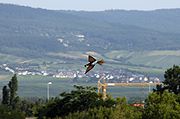
- Drifting chalk sands and dunes
In the cadastral areas of Nieder-Ingelheim and Frei-Weinheim, mainly north of the Autobahn along Konrad-Adenauer-Straße, but also south of the Autobahn – even within the Boehringer Ingelheim industrial lands – are found drifting chalk sands. Likewise a deposit is to be found in the area of the Griesmühle (mill).
These formations are under conservational protection under the Rhineland-Palatinate State Care Law. Damaging them or removing them, among other acts, is considered an incompensable encroachment on nature and the landscape. Municipal building uses in drifting chalk sand areas are therefore routinely excluded or only approved in very special cases. Two such exceptions were the building of Konrad-Adenauer-Straße (from the Autobahn bridge to Rheinstraße) and the building of the daycare centre on Sporkenheimer Straße.
Sport
- 1. Schwimmsportverein Ingelheim 1966 e.V. (swimming)
- RV Ingelheim
- SpVgg Ingelheim
- TUS Ober-Ingelheim
- Turngemeinde 1847 Corp. Nieder-Ingelheim (gymnastics)
- SV Ingelheim 1949 e.V.
- VfL Frei Weinheim
- HSC Ingelheim
- TV Frei-Weinheim (gymnastics)
- MFG-Ingelheim e.V. - Modellfluggruppe Ingelheim e.V.
- TSC Ingelheim
- FSC Ingelheim 07
Common welfare
- Mütter- und FamilienZentrum e.V. MütZe
The MütZe (“Mothers’ and Families’ Centre”, with the abbreviation resembling the word Mütze – “cap”) is to be found at the old Gymnasium
Gymnasium (school)
A gymnasium is a type of school providing secondary education in some parts of Europe, comparable to English grammar schools or sixth form colleges and U.S. college preparatory high schools. The word γυμνάσιον was used in Ancient Greece, meaning a locality for both physical and intellectual...
. The MütZe takes upon itself a generation-spanning exchange for all Ingelheim residents. A babysitter exchange, handicraft classes, breakfast and lunch, housework and holiday support are regularly offered, as well as courses and events covering every family theme from babies to health to creativity.
In Ingelheim there are also a House of Youth (Haus der Jugend, although this is soon to become a shopping centre and will be replaced with another House of Youth) and a Mehrgenerationshaus.
Regular events
- Since 1972 there has been a yearly folk music event, the Eurofolkfestival Ingelheim, on the Burgkirche Fairgrounds. It is said to be one of the successor festivals to the famous Waldeck-Festivals. A great number of the visitors are people from the hippie culture and youths from the local area and from throughout Germany. The number of visitors varies from 2,000 to 3,000. It is usually held between mid-June and mid-July and always lasts from Friday to Sunday. Out of the Eurofolkfestival grew the OpenOhr Festival (a youth cultural festival) in Mainz in 1974 and 1975.
- Hafenfest auf der Jungau (“Harbour Festival on the Jungau”), each year in early August.
- Ingelheimer Rotweinfest (“Ingelheim Red Wine Festival”) on the Burgkirche Fairgrounds, is held each year from the last weekend in September to the first weekend in October.
- Kerb in Groß-Winternheim (“kermis, or church consecration festival), second weekend in September
- Internationale Tage (“International Days”), each year since 1959.
- Umsonst-und-drinnen, international music festival for new blood groups.
- Kinderfest der DPSG Ingelheim (“Ingelheim DPSGDeutsche Pfadfinderschaft Sankt GeorgThe Deutsche Pfadfinderschaft Sankt Georg is the largest of Germany's many Scouting organizations. The Catholic association has about 95,000 members of both genders...
Children’s Festival”), each year on Ascension Day since 1969 on the Jungau in Frei-Weinheim. - Entekerb (“Harvest Kermis”), in October in Frei-Weinheim.
- Altstadtfest (“Old Town Festival”), second weekend in August, staged by NCI
- Fest der Generationen, second Saturday in September around the old Gymnasium, staged by the MütZe
Culinary specialities
Regional Rhenish-Hessian specialities are asparagusAsparagus
Asparagus officinalis is a spring vegetable, a flowering perennialplant species in the genus Asparagus. It was once classified in the lily family, like its Allium cousins, onions and garlic, but the Liliaceae have been split and the onion-like plants are now in the family Amaryllidaceae and...
and morello cherries
Cherry
The cherry is the fruit of many plants of the genus Prunus, and is a fleshy stone fruit. The cherry fruits of commerce are usually obtained from a limited number of species, including especially cultivars of the wild cherry, Prunus avium....
(a cultivar
Cultivar
A cultivar'Cultivar has two meanings as explained under Formal definition. When used in reference to a taxon, the word does not apply to an individual plant but to all those plants sharing the unique characteristics that define the cultivar. is a plant or group of plants selected for desirable...
of sour cherries
Sour Cherry
Prunus cerasus, or the sour cherry, is a species of Prunus in the subgenus Cerasus , native to much of Europe and southwest Asia. It is closely related to the wild cherry Prunus cerasus, or the sour cherry, is a species of Prunus in the subgenus Cerasus (cherries), native to much of Europe and...
).
Transport
The Autobahn A 60 runs through the municipal area and has two interchangeInterchange (road)
In the field of road transport, an interchange is a road junction that typically uses grade separation, and one or more ramps, to permit traffic on at least one highway to pass through the junction without directly crossing any other traffic stream. It differs from a standard intersection, at which...
s there. Bundesstraße
Bundesstraße
Bundesstraße , abbreviated B, is the denotation for German and Austrian national highways.-Germany:...
41 ends in Ingelheim. The Autobahnen A 61
Bundesautobahn 61
is an autobahn in Germany that connects the border to the Netherlands near Venlo in the northwest to the interchange with A 6 near Hockenheim. In 1965, this required a re-design of the Hockenheimring....
and A 63
Bundesautobahn 63
is an autobahn in southwestern Germany. It connects the Mainz area to Kaiserslautern and the A 6 and is therefore an important connection between the Rhine/Main and the Saar areas...
lie right nearby. Frankfurt Airport
Frankfurt Airport
Frankfurt Airport may refer to:Airports of Frankfurt, Germany:*Frankfurt Airport , the largest airport in Germany*Frankfurt Egelsbach Airport, a general aviation airport*Frankfurt-Hahn Airport , a converted U.S...
can be reached by Autobahn in roughly 30 minutes. Frankfurt-Hahn Airport
Frankfurt-Hahn Airport
-Cargo airlines:-Other facilities:AirIT Services AG, a subsidiary of Fraport, has its head office in Building 663 at Hahn Airport.-References:*Active Air Force Bases Within the United States of America on 17 September 1982 USAF Reference Series, Office of Air Force History, United States Air Force,...
can be reached in roughly 50 minutes by Autobahnen A 60 and A 61 or Bundesstraße 50.
Ingelheim lies on the Mainz-Bingen-Cologne (West Rhine Railway) and Saarbrücken-Mainz-Frankfurt railway lines. Between Ingelheim-Nord and Oestrich-Winkel
Oestrich-Winkel
Oestrich-Winkel is a town in the Rheingau-Taunus-Kreis in the Regierungsbezirk of Darmstadt in Hesse, Germany.- Location :This is a young town with roughly 12,000 inhabitants, having come into being in 1972 through the merger of the self-governing communities of Mittelheim, Oestrich and Winkel;...
runs a Rhine ferry. The constituent communities and the surrounding municipalities are served by city and regional bus routes of Omnibusverkehr Rhein-Nahe GmbH. The local rail transport is served by the Rhein-Nahe-Nahverkehrsverbund.
Established businesses
- Boehringer Ingelheim, pharmaceutical enterprise
- EA PhenomicEA PhenomicEA Phenomic is a real-time strategy video game developer, headquartered in Ingelheim, Germany, and founded as Phenomic Game Development in 1997...
, formerly Phenomic, video game developer - Goldener Engel, brewery
- Karl Gemünden, building company
- Rheinhessische Energie- und Wasserversorgungs-GmbH, energy and water supply
- Vereinigte Obst- und Gemüsemärkte (VOG), Europe’s biggest transshipment centre for sour cherries
- WetterKontor, supplier of weather information
Agricultural produce
Of the 4,987-hectare municipal area, 641 ha is used for winegrowing and 1 373 ha is used for crops. The main agricultural produce is sour cherries, asparagus and wine. Although the town lies in a region dominated by white wine, 54.9% of the vineyard area in Ingelheim am Rhein is used for growing red wine varieties. With 641 ha in vineyards, the town is moreover one of Rhenish Hesse’s biggest winegrowing centres after WormsWorms, Germany
Worms is a city in Rhineland-Palatinate, Germany, on the Rhine River. At the end of 2004, it had 85,829 inhabitants.Established by the Celts, who called it Borbetomagus, Worms today remains embattled with the cities Trier and Cologne over the title of "Oldest City in Germany." Worms is the only...
, (1,490 ha), Nierstein
Nierstein
Nierstein is an Ortsgemeinde – a municipality belonging to a Verbandsgemeinde, a kind of collective municipality – in the Mainz-Bingen district in Rhineland-Palatinate, Germany.- Location :...
(783 ha), Alzey
Alzey
Alzey is a Verband-free town – one belonging to no Verbandsgemeinde – in the Alzey-Worms district in Rhineland-Palatinate, Germany. It is the fourth-largest town in Rhenish Hesse, after Mainz, Worms, and Bingen....
(769 ha), Westhofen
Westhofen
Westhofen is an Ortsgemeinde – a municipality belonging to a Verbandsgemeinde, a kind of collective municipality – in the Alzey-Worms district in Rhineland-Palatinate, Germany.- Location :...
(764 ha), Alsheim
Alsheim
Alsheim is an Ortsgemeinde – a municipality belonging to a Verbandsgemeinde, a kind of collective municipality – in the Alzey-Worms district in Rhineland-Palatinate, Germany.- Location :...
(704 ha) and Bechtheim
Bechtheim
Bechtheim is an Ortsgemeinde – a municipality belonging to a Verbandsgemeinde, a kind of collective municipality – in the Alzey-Worms district in Rhineland-Palatinate, Germany...
(654 ha), and one of the biggest in the whole state
States of Germany
Germany is made up of sixteen which are partly sovereign constituent states of the Federal Republic of Germany. Land literally translates as "country", and constitutionally speaking, they are constituent countries...
of Rhineland-Palatinate
Rhineland-Palatinate
Rhineland-Palatinate is one of the 16 states of the Federal Republic of Germany. It has an area of and about four million inhabitants. The capital is Mainz. English speakers also commonly refer to the state by its German name, Rheinland-Pfalz ....
.
"The red wines of Ingelheim and Heidesheim (…) opposite to Eltville (…) enjoy a high reputation."
The Geisenheim Grape Breeding Institute
Geisenheim Grape Breeding Institute
The Geisenheim Grape Breeding Institute was founded in 1872 and is located in Geisenheim, Rheingau, Germany. In 1876 professor Hermann Müller from Switzerland joined the institution, where he developed his namesake variety Müller-Thurgau , which became the most planted grape variety in Germany in...
’s vegetable farming department runs an experimental asparagus field in Ingelheim. The research results can be viewed on the Internet.
Media
Local daily newspaperNewspaper
A newspaper is a scheduled publication containing news of current events, informative articles, diverse features and advertising. It usually is printed on relatively inexpensive, low-grade paper such as newsprint. By 2007, there were 6580 daily newspapers in the world selling 395 million copies a...
: Allgemeine Zeitung Ingelheim within the Rhein Main Presse, herausgegeben von der Verlagsgruppe Rhein Main, Mainz.
Municipal television: "Blickpunkt Ingelheim", which is broadcast every Monday and Thursday on regional channel K3.
Public institutions
Since 1996, Ingelheim has been the seat of district administration for Mainz-BingenMainz-Bingen
Mainz-Bingen is a district in the east of Rhineland-Palatinate, Germany. Neighboring districts are Rheingau-Taunus, the district-free cities Wiesbaden and Mainz, the districts Groß-Gerau, Alzey-Worms, Bad Kreuznach, Rhein-Hunsrück.-History:During the French occupation under Napoleon the district...
.
Education
Ingelheim is home to:- three primary schools (Präsident-Mohr-Grundschule, Theodor-Heuss-Grundschule, Brüder-Grimm-Grundschule)
- a combination primary school and HauptschuleHauptschuleA Hauptschule is a secondary school in Germany and Austria, starting after 4 years of elementary schooling, which offers Lower Secondary Education according to the International Standard Classification of Education...
(Pestalozzi-Grund- u. Hauptschule) - a professional college, die BBS Ingelheim
- a school for those with learning difficulties (Albert-Schweitzer-Sonderschule)
- a RealschuleRealschuleThe Realschule is a type of secondary school in Germany, Austria, Switzerland, and Liechtenstein. It has also existed in Croatia , Denmark , Sweden , Hungary and in the Russian Empire .-History:The Realschule was an outgrowth of the rationalism and empiricism of the seventeenth and...
(Kaiserpfalz-Realschule) - an integrated comprehensive schoolComprehensive schoolA comprehensive school is a state school that does not select its intake on the basis of academic achievement or aptitude. This is in contrast to the selective school system, where admission is restricted on the basis of a selection criteria. The term is commonly used in relation to the United...
(Kurt Schumacher) - a GymnasiumGymnasium (school)A gymnasium is a type of school providing secondary education in some parts of Europe, comparable to English grammar schools or sixth form colleges and U.S. college preparatory high schools. The word γυμνάσιον was used in Ancient Greece, meaning a locality for both physical and intellectual...
(Sebastian-Münster-Gymnasium)
Under the umbrella of the Ingelheim Further Education Centre Weiterbildungszentrum Ingelheim the following institutions work:
- Volkshochschule (folk high schoolFolk high schoolFolk high schools are institutions for adult education that generally do not grant academic degrees, though certain courses might exist leading to that goal...
) - Fridtjof-Nansen-Akademie für politische Bildung (political education)
- Music school
- Jugendbildungswerk (youth education)
Honorary citizens
- Robert BoehringerRobert BoehringerRobert Boehringer was a German industrialist and poet.Boehringer was the son of a factory owner. He spent his childhood, youth, and his student years in Basel, where he also had his Ph.D. approved at the local university. Until 1920 he was the head of the family firm C.H. Boehringer in Ingelheim...
, entrepreneur and lyricist, named an honorary citizen of Ingelheim in 1974 - Christian Rauch (b. 1878; d. 31 January 1976), archaeologist, named an honorary citizen of Ingelheim 16 December 1974
Sons and daughters of the town
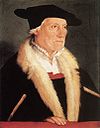
- Sebastian MünsterSebastian MünsterSebastian Münster , was a German cartographer, cosmographer, and a Hebrew scholar.- Life :Münster was born at Ingelheim near Mainz, the son of Andreas Munster. He completed his studies at the Eberhard-Karls-Universität Tübingen in 1518. His graduate adviser was Johannes Stöffler.He was appointed to...
(b. 20 January 1488, d. 26 May 1552), scientist (cosmographer, Hebraist) - Klaus KnopperKlaus KnopperKlaus Knopper is a German electrical engineer and free software developer. "My nationality from my passport is austrian, not german, though I will absolutely not complain about being listed as "german engineer", because I was born and have lived in Germany all of my life", - says Klaus...
(b. 1968), developer of Linux distribution KnoppixKnoppixKnoppix, or KNOPPIX , is an operating system based on Debian designed to be run directly from a CD / DVD or a USB key , one of the first of its kind for any operating system. Knoppix was developed by Linux consultant Klaus Knopper. When starting a program, it is loaded from the removable medium... - Markus KreuzMarkus KreuzMarkus Kreuz is a German football player who plays for WAC St. Andrä.-Career:He formerly played for VfL Frei-Weinheim, Mainz 05, Kaiserslautern, Hannover 96, 1. FC Köln, Eintracht Frankfurt, FC Rot-Weiss Erfurt, Real Murcia, Kickers Offenbach and FSV Frankfurt.-External links:...
(b. 1977), footballer
Other celebrities
- CharlemagneCharlemagneCharlemagne was King of the Franks from 768 and Emperor of the Romans from 800 to his death in 814. He expanded the Frankish kingdom into an empire that incorporated much of Western and Central Europe. During his reign, he conquered Italy and was crowned by Pope Leo III on 25 December 800...
, held court in Ingelheim in 807. - Louis the PiousLouis the PiousLouis the Pious , also called the Fair, and the Debonaire, was the King of Aquitaine from 781. He was also King of the Franks and co-Emperor with his father, Charlemagne, from 813...
, died in 840 in a summer tent on an island in the Rhine off Ingelheim - The House of Ingelheim, among them Anselm Franz von IngelheimAnselm Franz von Ingelheim (archbishop)Anselm Franz of Ingelheim was Archbishop-Elector of Mainz from 1679 until his death in 1695.Anselm became prince-bishop of Mainz on 7 November 1679 and thus was an elector of the Holy Roman Empire...
, Archbishop of Mainz - Jean-Baptiste Kléber, during the Siege of Mainz in 1793 headquartered in Ingelheim
- Eduard Douwes Dekker, known as Multatuli (b. 2 March 1820 in Amsterdam; d. 19 February 1887 in Ingelheim am Rhein)
- Richard von WeizsäckerRichard von WeizsäckerRichard Karl Freiherr von Weizsäcker , known as Richard von Weizsäcker, is a German politician . He served as Governing Mayor of West Berlin from 1981 to 1984, and as President of the Federal Republic of Germany from 1984 to 1994...
, from 1962 to 1966 managing partner of Boehringer Ingelheim - Pope JoanPope JoanPope Joan is a legendary female Pope who, it is purported, reigned for a few years some time in the Middle Ages. The story first appeared in the writings of 13th-century chroniclers, and subsequently spread through Europe...
, Johanna von Ingelheim, a perhaps real, perhaps fictitious figure
Further reading and maps
- Hans-Georg Meyer; Gerd Mentgen: Sie sind mitten unter uns: zur Geschichte der Juden in Ingelheim. Ingelheim 1998 ISBN 3-924124-29-9
- Friedrich, Reinhard [Hrsg.]: Karl der Große in Ingelheim: Bauherr der Pfalz und europäischer Staatsmann; Katalog zur Ausstellung im Alten Rathaus Nieder-Ingelheim, 29. August bis 27. September 1998. Ingelheim 1998. ISBN 3-00-003290-8
- Landesamt für Vermessung und Geobasisinformation Rheinland-Pfalz: Ingelheim am Rhein. Topographische Karte 6014 (1:25.000). ISBN 3-89637-076-6
Documents
- picture of Oberingelheim from J.F. Dielmann, A. Fay, J. Becker (draughtsman): F.C. Vogels Panorama des Rheins, Bilder des rechten und linken Rheinufers, Lithographische Anstalt F.C. Vogel, Frankfurt 1833

